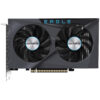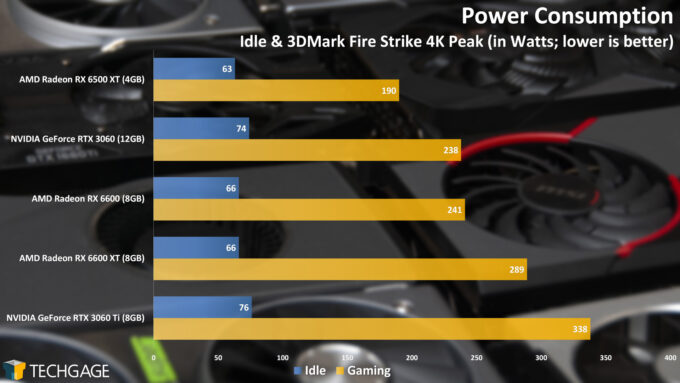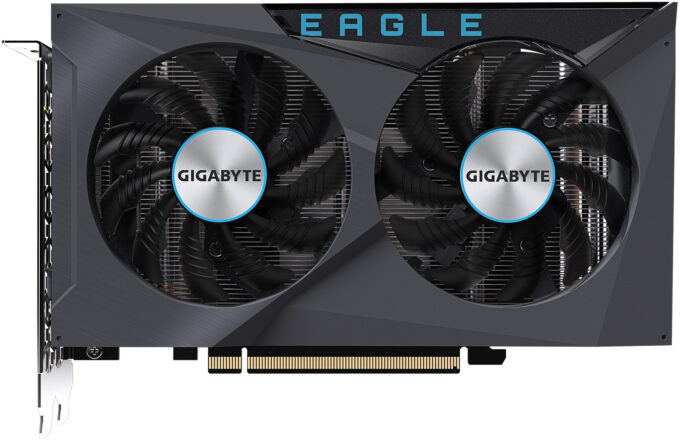- Qualcomm Launches Snapdragon 4 Gen 2 Mobile Platform
- AMD Launches Ryzen PRO 7000 Series Mobile & Desktop Platform
- Intel Launches Sleek Single-Slot Arc Pro A60 Workstation Graphics Card
- NVIDIA Announces Latest Ada Lovelace Additions: GeForce RTX 4060 Ti & RTX 4060
- Maxon Redshift With AMD Radeon GPU Rendering Support Now Available
Budget RDNA2: A Review Of AMD’s $199 Radeon RX 6500 XT

AMD becomes the first major GPU vendor to release a new model in 2022, and it comes to us in the form of a new lower-end part: Radeon RX 6500 XT. This latest Radeon slots into the $199 price-point, but while it’s a more modest part, there’s still quite a bit to talk about. Let’s dig in and see how it performs against AMD’s and NVIDIA’s current-gen lower-end cards.
Page 3 – Power Consumption & Final Thoughts
Power Consumption
To take a look at GPUs from a power perspective, we’re using UL’s 3DMark Fire Strike 4K stress test, and the PC plugged into a Kill-A-Watt to monitor full system power draw. The PC is left to sit idle for about five minutes, or at least until the PC is idle, at which point that number is recorded. After five minutes of running the Fire Strike test, the load value is recorded (at the same point in the looped test).
Being the lowest-end graphics card of the entire current generation, it probably won’t surprise anyone that the RX 6500 XT sips the least amount of power. That could also be further proven by the fact that the card is the only one from the entire current-gen lineup that requires only one 6-pin connector.
Final Thoughts
AMD’s new Radeon RX 6500 XT may be a lower-end GPU, but while that typically could mean there won’t be much to talk about, we’re dealing with a unique case here. The RX 6500 XT performed well across all of our tested modern games when settings were dialed-in right, but it’s obvious to us that if this card had 8GB of memory instead of only 4GB, it’d actually make a notable improvement in some cases.
When you compare the RX 6500 XT, with its 1,024 cores, against the RX 6600 XT, with 1,792 cores, you can probably conjure up ideas of how the two cards should perform against each other. Well, in the cases of games like Assassin’s Creed Valhalla, our higher-end graphics detail settings proved far too much for the RX 6500 XT, holding it much further back than we’d expect. We saw similar deltas between the two GPUs in F1 2021, Forza Horizon 5, and Watch Dogs Legion.
What’s most difficult to ignore with the RX 6500 XT is that in some ways, it’s a downgrade over similarly-priced cards of the previous generation. That’s especially the case when you consider the RX 6500 XT bucks trends by ditching AVC/HEVC encode acceleration. Further, unlike the rest of the lineup above the RX 6500 XT, this new $199 offering lacks AV1 decode acceleration.
AMD’s Radeon RX 480 from 2016, and RX 580 from 2017, both came in with 4GB for the $199 version (with an 8GB version costing $30-40 more). Fast-forward to 2019, when the company released a $199 RX 5500 XT with a 8GB frame buffer. That card is best compared to this RX 6500 XT, so we regret not having benchmarks for it in this article.
That said, we did get a little hands-on testing done with the RX 5500 XT to see how the 8GB frame buffer would impact certain workloads, and what we suspected was true: the 4GB frame buffer of the RX 6500 XT can really hold it back in places. In fact, the RX 6500 XT performs similarly to the RX 5500 XT, so the reality is this: AMD’s new $199 card is generally faster than RX 5500 XT when there are no frame buffer limits, but when it comes to video encode and higher detail levels, the new RX 6500 XT is actually a downgrade.
We feel like AMD was stuck in a rough spot with the RX 6500 XT. The current state of the market means that producing a card is more expensive than it was a handful of years ago due to chip shortages, and it’s likely that reason why seemingly basic features such as video encoding acceleration have been lobbed off – and not to mention half the VRAM. Still, when the last-gen $199 actually seems more attractive than the new one, it shows we’re really in the middle of a unique era of semiconductors. AMD likely can’t keep making the 5500 XT for the same $199 price, either, so it was left with the choice of either lowering specs, or increasing the price of the card.
What will also add a bit more color to this entire low-end GPU equation is NVIDIA’s upcoming GeForce RTX 3050. Priced at $249, and equipped with an 8GB frame buffer, we’re eager to see how it stacks up against the RX 6500 XT.
Support our efforts! With ad revenue at an all-time low for written websites, we're relying more than ever on reader support to help us continue putting so much effort into this type of content. You can support us by becoming a Patron, or by using our Amazon shopping affiliate links listed through our articles. Thanks for your support!







